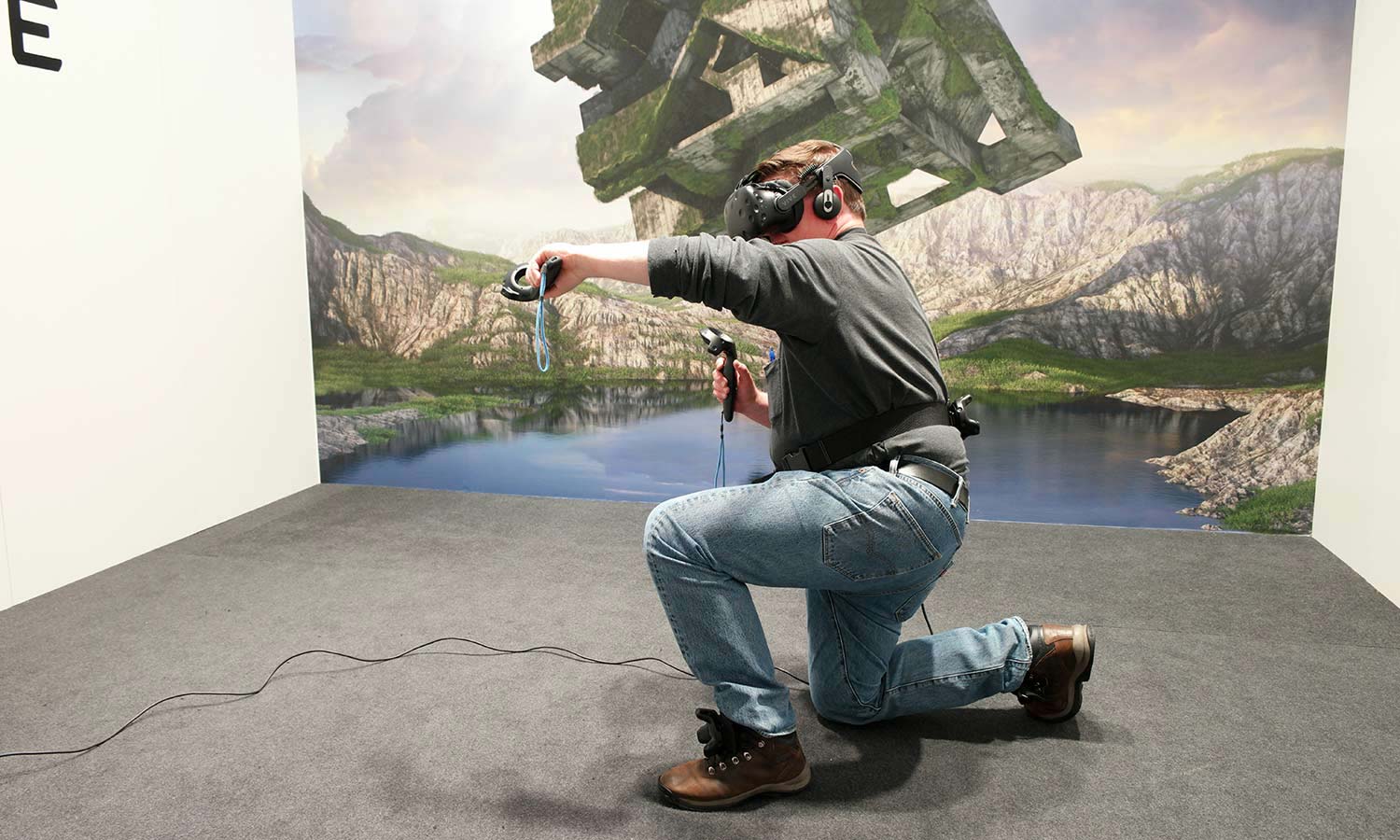I Kicked Velociraptors in the Head with HTC's Vive Trackers
After unveiling Vive Trackers last month, HTC has set the price at $99 for the devices that add real objects into the virtual world.
Thanks to the HTC Vive Tracker, when I strap on a Vive headset, I've now got virtual legs. And I know how to use them.

HTC first introduced the Vive Tracker a month ago at CES. It's a hockey puck-sized device that lets developers incorporate real-world objects into virtual reality, whether that's a baseball bat, a handheld spray painter or — in my case — my own two feet.
Just this week, HTC announced that the Vive Tracker will be available to developers for $99 starting on March 27. (Consumers will be able to buy the tracker later in the year when there's content to support it.) The Vive Audio Deluxe Strap, an accessory which promises 360-degree audio and an adjustable sizing strap, will also cost $99 and will be available for pre-order on May 2.
The velociraptors charged at me with bloodthirsty abandon, and if my bullets didn't bring them down, a good swift kick kept them at bay until I reloaded.
This week's Mobile World Congress gave HTC another opportunity to show off just what could be done with the Vive Tracker. A developer by the name of CloudGate was up to the task, demoing its Island 359 game which uses the trackers to bring your entire body into the virtual world instead of just a floating pair of hands.
But to experience full body awareness, you're going to have to kit up. Besides donning an HTC Vive headset, I slipped two Vive Trackers over my boots and strapped another one around my waist. By the time I grabbed the touch controllers, I probably looked more machine than man. But when I looked in a virtual mirror in the Island 359 game, my avatar had both arms and legs, so it was all worth it.

Of course, there's a cost beyond just strapping yourself down with trackers. Using the $99 that a Vive Tracker sells for, that's another $297 to add onto the Vive headset's $799 price tag, and that's before you factor in the PC you'll need to help deliver all that VR content.
MORE: Best VR Headsets - Virtual Reaility for PCs and Smartphones
Island 359 itself is a pretty fun game, that's made much more enjoyable with the presence of your virtual legs. You're hunting dinosaurs with just a gun in one virtual hand and a knife in the other. The velociraptors charge at you with bloodthirsty abandon and if your bullets don't bring them down, a good swift kick might keep them at bay until you can reload.
I'm also not ashamed to admit it is surprisingly cathartic to put a boot into the corpses of the raptors you've filled full of lead. Who's extinct now, buddy?
For a demo, things ran pretty smoothly during my time playing Island 359. The biggest problem I ran into was kicking a little too vigorously, which sent the Vive Tracker flying, and left me with just one virtual leg to stand on.
HTC showed off a more practical use for its tracker, too, strapping one of the devices to a spray paint simulator that could be used to train workers on how to efficiently and accurately paint the exterior of a car. You operate the paint sprayer in a virtual world, while a software program calculates where you've applied too much or too little paint. I'm apparently better at spray painting cars than I am at murdering dinosaurs.

HTC also showed off a technology it's dubbed HTC people, which is basically a piece of printed paper folded up like a magazine with a series of squiggles printed on the front. Hold up the paper in front of your HTC Vive googles, though, and a selection of virtual magazines appears. You can select one and thumb through it by opening the real folded paper, and then making a flipping motion with your hand. Each page features pop-up content like videos and pictures that appear before you in VR.
Get instant access to breaking news, the hottest reviews, great deals and helpful tips.
The demo wasn't flawless, I had a hard time getting the virtual pages to flip with my gestures — so much so that I wondered why I wasn't just reading an actual magazine instead of going through all this hassle. But at the very least, it shows HTC exploring new apps that try to establish the Vive as something more than a high-tech gaming console.
Photo Credits: Sam Rutherford/Tom's Guide
Philip Michaels is a Managing Editor at Tom's Guide. He's been covering personal technology since 1999 and was in the building when Steve Jobs showed off the iPhone for the first time. He's been evaluating smartphones since that first iPhone debuted in 2007, and he's been following phone carriers and smartphone plans since 2015. He has strong opinions about Apple, the Oakland Athletics, old movies and proper butchery techniques. Follow him at @PhilipMichaels.

